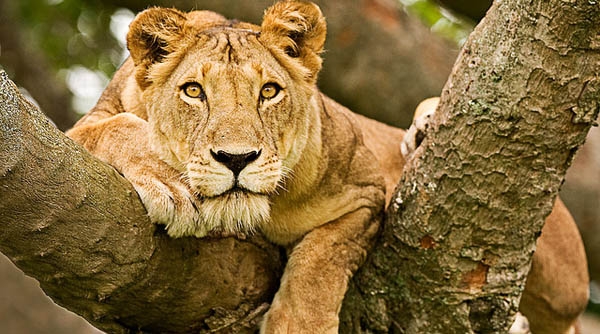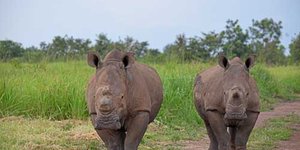Like this article?
Go on, give it a kudu!

Published on November 06 2013
Written by:
Fran
918 views
The King of Africa’s animal kingdom is in danger. Throughout Africa but particularly in East Africa, lion populations are declining fast. Recent habitat studies along with specific research done by the Wildlife Conservation Society and the University of St. Andrews, reported some worrying news.
Lion counts
Three key conservation areas in Uganda were recently surveyed and the lion population counts were compared to the counts of ten years ago. These three conservation regions under the close inspection of conservation scientists included the Queen Elizabeth Conservation Area, the Murchison Falls Conservation Area and the Kidepo Valley National Park. In two of these three protected regions, severe lion population decline is a reality; the third brought some positive news. The results of the lion census were as follows:
- The lion population of the Queen Elizabeth Conservation Area declined by 30%.
- The lion population of the Murchison Falls Conservation Area declined by 60%.
- Kidepo’s small lion population more than doubled, currently totaling at 132 lions.
With the exception of Kidepo’s lion population, the decline in lion population is a grave concern. The news of the Queen Elizabeth Conservation Area and Murchison’s lions are particularly sad news – these were once the world’s richest animal kingdom spots.
What are the lion’s greatest threats?
Africa has seen and experience human and carnivore conflict for centuries and a complex relationship between humans and Africa’s wildlife continues to rule in almost every African country. In Uganda, there is a particularly fierce competition between rural communities and large carnivores including lions and leopards. This competition is worsened by the fact that lions preyed on communities for decades, and continue to do so. Now, the lions are paying the price through either poisoning or retaliation killings by livestock farmers and rural communities. Rural Ugandans have a very low tolerance level when it comes to their lion population, and this is exactly the reason why conservation scientists believe that lions may be on the verge of disappearing in some parts of East Africa. A third threat to the lions’ safekeeping is the trade of wild bush meat – something that continues to gain ground in rural Africa.
Tourist attraction but also ecosystem driver
Lions are undoubtedly Africa’s greatest tourist attraction. In fact, the Wildlife Conservation Society believes that lions are so popular, that a large percentage of tourists will refrain from visiting a national park of there are no lion to spot. But apart from tourism, lions have very important ecological roles to fulfill, from keeping antelope disease under control to managing ecosystem balances. Without healthy lion numbers, the delicate savannah ecosystem balance will be turned upside down, threatening the existence of other species as well as overall habitat health.
The need for conservation intervention
There is a huge and urgent need for conservation intervention, particularly in Uganda and other East African countries. As far as functional ecosystems are concerned, South African conservation scientists have advice to offer, and are calling for the development of community relationships and the establishment of lion buffer zones. Ugandan conservation officials are urged to manage lion populations from both inside and outside protected areas – giving an overarching conservation approach. Today, we know that many wildlife threats are directly related to socio-economic issues. Solutions for saving Uganda’s lions need long-term economic incentives to persuade rural Ugandans to let live rather than kill. If the next decade for Uganda’s lion population should mean as much lion killings as the past decade, saving the Ugandan lion population could be incredibly difficult. Conservation scientists are agreeing that time is extremely limited, and lion conservation actions across all socio-economic sectors are urgently needed, or else, the King of Africa could very well disappear in localized regions.
Photo credits: some rights reserved by Merv Colton via flickr [Creative Commons]
Has been on: 11 safaris
Seeing beyond the average tourist routes and experiencing local life is my type of travel! Living in South Africa I'm an environmentalist at heart, and I continue to marvel at the beauty of the African continent.
© Your African Safari Ltd, All rights reserved.
Your African Safari is a safari-planning and safari review site. It was created to help support a healthy African wildlife population. All reviews are vetted before being approved and only ethical tours are published

Garamba National Park—an anchor of hope in the Democratic Republic of Congo
Published on January 09 2025
By: R.W.

Namibia imposes new visa requirements
Published on July 25 2024
By: yourafricansafari.com

Do I really need travel insurance or travel protection for my safari?
Published on July 30 2024
By: yourafricansafari.com